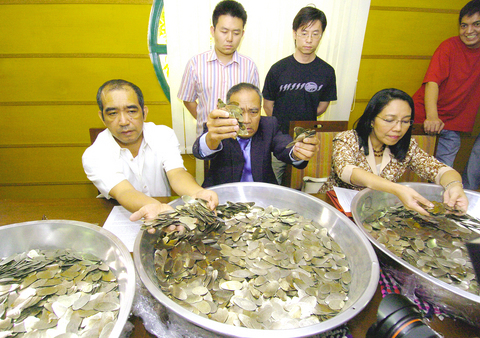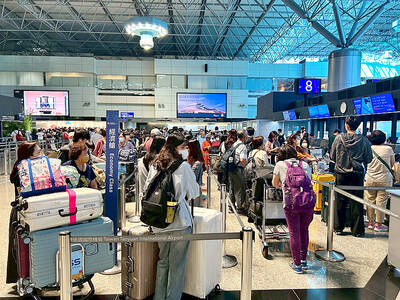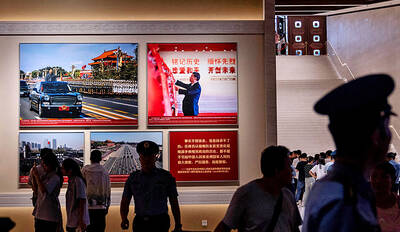Two Taiwanese nationals were arrested for allegedly trying to smuggle 7 tonnes of Philippine one-peso coins to China for their nickel content, the National Bureau of Investigation said yesterday.
This was the latest in a series of attempts to smuggle coins out of the country so that they could be melted down for their metal, officials said.
The suspects, identified by the last names Lin and Hsin, were arrested during two raids over the weekend in Manila, bureau regional chief Ruel Lasala said.

PHOTO: AFP
About a million flattened coins were seized in the raids, Lasala said.
The two suspects face charges of mutilating Philippine currency, but Lasala said that the investigations were continuing to see if they could be charged with more serious crimes.
The bureau had information that the two Taiwanese individuals may have already smuggled out some 45 tonnes of flattened one-peso coins to China, Lasala added.
The suspects had apparently resorted to flattening the coins so that they could be shipped out of the country as ordinary base metals.
The Customs Bureau seized three shipments consisting of millions of one-peso coins from February to July, the investigation bureau official said.
Lasala said that it was not known whether the two suspects had been involved in the previous attempts to smuggle out coins.
The rising price of nickel has made the metal content of the one-peso coin worth more than its face value, which is about US$0.02.
According to local media reports, the coins are sold in China for US$20 per kilogram.
In an effort to cut down smuggling, the Philippine Central Bank is now minting one-peso coins using a cheaper alloy.

Three batches of banana sauce imported from the Philippines were intercepted at the border after they were found to contain the banned industrial dye Orange G, the Food and Drug Administration (FDA) said yesterday. From today through Sept. 2 next year, all seasoning sauces from the Philippines are to be subject to the FDA’s strictest border inspection, meaning 100 percent testing for illegal dyes before entry is allowed, it said in a statement. Orange G is an industrial coloring agent that is not permitted for food use in Taiwan or internationally, said Cheng Wei-chih (鄭維智), head of the FDA’s Northern Center for

The Chinese military has built landing bridge ships designed to expand its amphibious options for a potential assault on Taiwan, but their combat effectiveness is limited due to their high vulnerability, a defense expert said in an analysis published on Monday. Shen Ming-shih (沈明室), a research fellow at the Institute for National Defense and Security Research, said that the deployment of such vessels as part of the Chinese People’s Liberation Army (PLA) Navy’s East Sea Fleet signals a strong focus on Taiwan. However, the ships are highly vulnerable to precision strikes, which means they could be destroyed before they achieve their intended

About 4.2 million tourist arrivals were recorded in the first half of this year, a 10 percent increase from the same period last year, the Tourism Administration said yesterday. The growth continues to be consistent, with the fourth quarter of this year expected to be the peak in Taiwan, the agency said, adding that it plans to promote Taiwan overseas via partnerships and major events. From January to June, 9.14 million international departures were recorded from Taiwan, an 11 percent increase from the same period last year, with 3.3 million headed for Japan, 1.52 million for China and 832,962 to South Korea,

REWRITING HISTORY: China has been advocating a ‘correct’ interpretation of the victory over Japan that brings the CCP’s contributions to the forefront, an expert said An elderly Chinese war veteran’s shin still bears the mark of a bullet wound he sustained when fighting the Japanese as a teenager, a year before the end of World War II. Eighty years on, Li Jinshui’s scar remains as testimony to the bravery of Chinese troops in a conflict that killed millions of their people. However, the story behind China’s overthrow of the brutal Japanese occupation is deeply contested. Historians broadly agree that credit for victory lies primarily with the Chinese Nationalist Party (KMT)-led Republic of China (ROC) Army. Its leader, Chiang Kai-shek (蔣介石), fled to Taiwan in 1949 after losing a